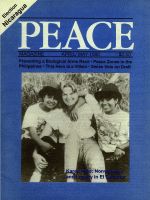
Peace Magazine Apr-May 1990, page 22. Some rights reserved.
Search for other articles by Erhard Geissler here
Biological weapons: living organisms and viruses that are deliberately used for hostile purposes to cause disease or death. Their effects usually depend on their ability to multiply in the organism attacked
Toxic weapons: poisonous chemical compounds originally derived from living organisms which are deliberately used for hostile purposes to cause disease or death. In contrast to biological weapons, their effects depend on direct toxicity. Because they are non-living, they are a type of chemical weapon.
Biological and toxic weapons (B & TWs) have been of little military use until recently because they failed to meet four basic criteria:
President Nixon, noting the disadvantages of BW agents, in 1969 unilaterally renounced their use by the U.S. The development, production, acquisition, transfer, stockpiling, and use of B & TWs have been prohibited by widely ratified international treaties.
However, in recent years, genetic engineering may have made biological warfare feasible. Viruses and toxins can now be studied, manipulated, and mass produced with relative safety. They have replaced bacteria as the most common type of potential B & T.
Pathogens can be developed that can overcome the immune barriers of a potential enemy and that are resistant to the drugs available to an enemy.
The Biological Weapons Convention binds only governments of Stales Parties-not their respective populations. Domestic legislation is necessary to prevent criminal access to such agents. Nevertheless, only a minority of States-Australia, Belgium, France, the Netherlands, New Zealand, Norway, and Britain-have incorporated the Convention into national law, as they are obliged to do under the terms of the treaty.
Most of the toxins studied by the U.S. research program are available from commercial companies that sell to biomedical laboratories. Until recently it was possible for non-authorized persons to obtain the material. Legislation is still lacking to prevent access to it bv terrorists and by the secret service.
Some 60 countries (mostly of the Third World) have not yet ratified the Convention, and numerous other States Parties to the Geneva Protocol have reserved the right to use chemical and bacteriological weapons if an adversary should use them first. This reservation contradicts the provisions of the Biological Weapons Convention and raises concern about adherence to it.
The Convention has loopholes: thus, although prohibiting the development and production of B & TWs, it does not forbid research or the development, production, and stockpiling of BW and TW agents for protective or other "peaceful" purposes. Indeed, biological warfare experts hold that the development of defensive measures requires investigation of offensive possibilities.
Such defensive activities are proliferating, increasing the danger to personnet and to the public. The leading research institution, Fort Detrick, Maryland, has experienced fire in a containment laboratory, misplaced vials of BW agents, laboratory spills, and employee exposures to BW agents.
The development of vaccines is a problematic issue. It is legitimate for governments to develop vaccines to protect personnel, including soldiers, serving where certain pathogens are endemic. U.S. soldiers in Vietnam were hospitalized more oflen because of infectious diseases than because of hostile action. However, other agents that are endemic in Southeast Asia are potential biological warfare agents. Vaccination, if used to protect researchers in offensive programs, and troops before an attack, would provide first-strike capability.
Verification of compliance with the Convention is not feasible. An additional protocol is needed to make participation in the exchange of scientific information legally binding.
To strengthen the BW Convention:
(a) Scientists should declare that they will not participate in offensive biological and toxin weapons research and development. (b) Scientists in nations that have not ratified the treaties should press their governments to do so. (c) States Parties which have declared their right to use, in retaliation, weapons banned by the Geneva Protocol, should withdraw their reservation. This includes Canada. (d) Scientists should work together on long-term visits in facilities where work is done relating to the Convention.
Professor Geissler is a geneticist at the Academy of Sciences, GDR, 115 Berlin-Buch.

Peace Magazine Apr-May 1990, page 22. Some rights reserved.
Search for other articles by Erhard Geissler here